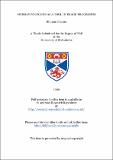Murray polygons as a tool in image processing
Abstract
This thesis reports on some applications of murray polygons, which are a generalization of space filling curves and of Peano polygons in particular, to process digital image data. Murray techniques have been used on 2-dimensional and 3-dimensional images, which are in cartesian/polar co-ordinates. Attempts have been made to resolve many associated aspects of image processing, such as connected components labelling, hidden surface removal, scaling, shading, set operations, smoothing, superimposition of images, and scan conversion. Initially different techniques which involve quadtree, octree, and linear run length encoding, for processing images are reviewed. Several image processing problems which are solved using different techniques are described in detail. The steps of the development from Peano polygons via multiple radix arithmetic to murray polygons is described. The outline of a software implementation of the basic and fast algorithms are given and some hints for a hardware implementation are described The application of murray polygons to scan arbitrary images is explained. The use of murray run length encodings to resolve some image processing problems is described. The problem of finding connected components, scaling an image, hidden surface removal, shading, set operations, superimposition of images, and scan conversion are discussed. Most of the operations described in this work are on murray run lengths. Some operations on the images themselves are explained. The results obtained by using murray scan techniques are compared with those obtained by using standard methods such as linear scans, quadtrees, and octrees. All the algorithms obtained using murray scan techniques are finally presented in a menu format work bench. Algorithms are coded in PS-algol and the C language.
Type
Thesis, PhD Doctor of Philosophy
Collections
Items in the St Andrews Research Repository are protected by copyright, with all rights reserved, unless otherwise indicated.

